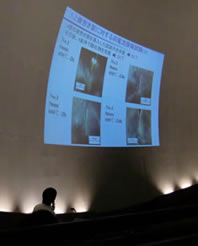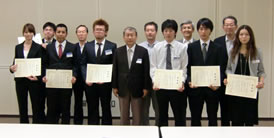Day Three (July 15, 2010)
[A-5] Maintenance Methods and Welding Technology (Part I)
[B-4] Maintenance sociology (Part II "Consensus Building")
[B-5] Maintenance Methods and Welding Technology (Part II)
[C-4] Online maintenance
[C-5] Condition Monitoring
[E-4] Industry-academic Collaboration (Part II)
[E-5] Structure and Material Intensity
[F-4] Student Session
[F-4]Student Session
- F-4-1
- Frequency Dependence in the Measurement of Pipe Wall Thinning Using Time-Domain Microwave Testing
Abstract
Position of pipe wall thinning was evaluated quantitatively by using time domain measurement of microwaves, and the influence of the measurement sensitivity due to the frequency band of microwaves was investigated. Microwave signals having different frequency bands of 10MHz to 40GHz and 10MHz to 67GHz were transmitted from the terminal of a straight line copper pipe, and the change in the response of the reflected signals was measured. By selecting the narrower frequency band, the measurement noises were alleviated, and the reflected signals at the both ends of the wall thinning were detected successfully. It was found that the position and length of the wall thinning could be evaluated with higher precision by selecting the appropriate frequency band.
Keywords
Microwave, Nondestructive evaluation, Wall thinning, Pipe, Time domain
- F-4-2
- PROPOSAL OF AN INTERNAL BURST PRESSURE EQUATION APPLICABLE TO PLANAR/NON-PLANAR FLAW IN WALL THINNED PIPES
Abstract
In this paper, an internal burst pressure equation applicable to all types of planar and non-planar flaw in wall thinned straight pipes was proposed. An idea to rationally classify planar/non-planar flaw in wall thinned pipes was proposed, based on the experimental observation focused on the fracture mode. The results point out the importance to distinguish axially and circumferentially long flaws in wall thinned pipes.
Keywords
Experimental Stress Analysis, Ductile Fracture, Stress Concentration, Fracture Criterion, wall-thinned pipes, Size Effect, Burst Pressure Equation, Fracture Mode
- F-4-3
- Experimental research on mass flow accelerated corrosion mechanism behind the orifice
Abstract
Flow Accelerated Corrosion (FAC) is thought to be the origin of the pipe thinning in the pipe of second cooling system of power plants. FAC is a phenomenon that inclined to and promoted the corrosion because of the increase of the complex turbulent flow behind the orifice. Now the analysis of the mechanism of FAC for maintenance of the nuclear reactor is performed. Although the rough surface is confirmed over the pipe wall, influence of the shape on the corrosion is not understood at this stage. Therefore, it aims at the investigating the mechanism of the flow accelerated corrosion under the rough surface in the present study. We measure the mass transfer rate directly with electrochemical method at the wall with the influence of the ruggedness elements.
Keywords
Flow Accelerated Corrosion, Mass transfer rate, Rough Wall surface
- F-4-4
- Numerical research on flow accelerated corrosion mechanism behind the orifice - Numerical simulation close to the wall -
Abstract
The accident to which the secondary system piping of the Mihama Power Station Unit-3 was damaged in August, 2004 happened. This is due to thinning of the pipe, and it is thought to be flow accelerated corrosion mechanism (FAC). The turbulence kinetic energy is considered as one of the flow factors in FAC. This is because the location where the amount of thinning is large and the parts where the turbulence kinetic energy is high are corresponding comparatively well. However, the causal relation between both parts is not clarified enough and the research advances now. Then, the flow field in the orifice downstream is calculated by the numerical simulation. The numerical simulation of LES in flow field (Re=25000) in the orifice downstream is performed. The distribution of the turbulence kinetic energy indicates the maximum value at the position that depended on β of the open area ratio of the orifice. In the rough side shape, the position in which the turbulence kinetic energy shows the maximum changes depending on the distance from the wall.
Keywords
Orifice, flow accelerated corrosion , LES, and turbulence kinetic energy
- F-4-5
- Study on permeation behavior of hydrogen isotope in stainless steel
Abstract
Stainless steel is used in various nuclear installations as a major structural material. Tritium is produced by several nuclear reactions in these facilities. It is considered that the hydrogen isotope included tritium permeated for stainless steel through the interaction such as dissolution, diffusion and recombination, and is released on the atmosphere. Therefore, it is important to clarify permeation behavior of tritium in stainless steel from the viewpoint for improvement of the social acceptability of the nuclear energy and safety. In this study, deuterium experiments for each temperature and pressure were carried out. As a result, chemical state of deuterium permeation was gaseous state. In addition, activation energy of permeated deuterium was 0.30±0.01 eV.
Keywords
permeation, hydrogen isotope, stainless steel, chemical state, activation energy
- F-4-6
- Potentiostatic Etching Method for Detection of Pre-existing Plastic Strain in Austenitic Stainless Steel
Abstract
To ensure integrity of the structure such as nuclear power plant, the demand has been increased for establishing nondestructive method for detection of pre-existing plastic strain. In this study, potentiostatic etching method is applied to detect and measure plastic strain imposed to austenitic stainless steel by tensile straining. After potensiostatic etching (1N HNO3, -600mVSCE, 20min), the twin band appears as etched line on the surface of specimens. The etched twin band is observed by optical microscope and quantified as the etched twin band density. There is one to one relation between the etched twin band density and the amount of pre existing plastic strain in the range from 1% to 30%.
Keywords
Plastic Strain, Stainless Steel, Potentiostatic Etching, Nondestructive Evaluation, Deformation Twin
- F-4-7
- Measurement of Inner Residual Stress of Bearing by Neutron Diffraction Technique
Abstract
Neutron diffraction technique is one of prevailing method to measure inner structure of material, such as molecular arrangement and lattice spacing by means of penetration of neutron. In particular the residual stress measurement by neutron diffraction has been developed and is greatly performed in many research facilities, because the examination of residual stress existing materials is critically important to estimate fatigue of the materials and to maintain structural objects for efficient utilization. We performed a measurement of residual stress of bearings used for rotating equipment at power plant in the JRR-3 (JAEA) after performing loading rotation test on the bearings. The measuring machine is called RESA(Neutron Diffractometer for Residual Stress Analysis ). We used two samples, one was new and the other was fatigued by the test above. The result indicates us that the inner residual stress distribution clearly changed. We summarize this difference and consider several possible causes below.
Keywords
Neutron Diffraction, Residual Stress, Bearing, Condition-Based Maintenance
- F-4-8
- Expression by T33-stress of Thickness Effect on Fracture Toughness; Difference in Specimen Type
Abstract
This paper considered i) thickness effect and ii) difference in test specimen structure, on the fracture toughness of a material in the transition temperature region. First, the thickness effect on the T33-stress, which is the out-of-plane elastic crack tip constraint parameter, was studied. Then, an experimental expression on thickness effect on the fracture toughness by using T33-stress was proposed for carbon steel S55C, for 3PB (3 point bending). Finally, this experimental expression was shown to describe difference in CT specimens.
Keywords
Fracture mechanics, Elastic T-stress, Constraint effect, Fracture toughness, Cleavage, Transition temperature, 3PB specimen, CT specimen, Thickness effect
- F-4-9
- Change in the system free energy of 9Cr heat resistant ferritic steels with creep time
Abstract
Microstructural state of metallic materials can be expressed by the system free energy, and the estimation of the system free energy is useful for the damage analysis of the materials. In this study, change in the system free energy of 9Cr heat resistant ferritic steels is estimated with creep time on the basis of Thermo-Calc calculation as well as a series of experiments such as X ray diffraction analysis, chemical analysis using extracted residues, etc., and the change with creep time is expressed quantitatively by introducing the relaxation time into the system free energy.
Keywords
ferrtic steels, creep, microstructure, Thermo-Calc, system free energy
- F-4-10
- Evaluation of Residual Stress Distribution due to Welding and Surface Machining and Crack Growth Behavior
Abstract
In nuclear power plants, stress corrosion cracking has been observed near the weld zone of the primary loop recirculation pipes made of low-carbon austenitic stainless steel Type 316L. Residual stress is important factor in the occurrence and propagation of SCC. The joining process of pipes usually includes surface machining and welding, and both processes induce residual stresses. In this study, FEM was used to estimate residual stress distributions generated by butt welding and surface machining. In addition, a crack growth analysis based on the stress intensity factor (SIF) calculation was performed using the calculated residual stress distributions that are generated by welding and surface machining. As a result, the crack growth analysis showed that the crack depth is affected by both surface machining and welding, and the crack length is more affected by surface machining than by welding.
Keywords
Residual stress, SCC, Welding, Surface Machining, Crack Growth
- F-4-11
- Evaluation of the influence of crack branching structure and oxide fillings of stress corrosion cracking for depth sizing based on eddy current testing
Abstract
This study discusses the stress corrosion cracking (SCC) model which improves accuracy of depth sizing of SCCs with eddy current testing (ECT). For this purpose, the factors that influence ECT for SCCs are evaluated. In this study, the crack morphology and oxide fillings in SCCs are evaluated. As a first step, SCCs introduced at room temperature and fatigue cracks with oxide fillings are evaluated. To discuss the EC signals of SCCs, SCCs are artificially introduced and their ECT signals are obtained. The EC signals of SCCs are much smaller than that of fatigue cracks. To discuss the influence of oxides in fatigue cracks on EC signals before SCC, oxides are systematically filled in fatigue cracks by thermal treatment, and their EC signals are obtained. The EC signals are changed before and after filling oxides and different from the type of oxide fillings.
Keywords
Eddy current testing, Stress corrosion cracking, Electromagnetic nondestructive evaluation, Depth sizing, Oxidation
- F-4-12
- Research and development of real-time atmospheric tritium monitor by polyimide hollow fiber
Abstract
Tritium from the nuclear power plants should be monitored at real-time. The development of real-time atmospheric tritium monitor is an important issue, since it was reported that tritium from the nuclear power plants was released as the form of HT and HTO, and released tritium was adsorbed plants and transported to human through photosynthesis and food chain processes. This study was carried out to develop the separation-condensation technique for tritium using polyimide hollow fiber module. At first, ion chamber was calibrated using tritiated water. From the results of measurement, the equation for conversion from ionization current to radioactivity was determined.
Keywords
polyimide hollow fiber, atmospheric tritium, real-time monitor
 |
 |
|---|---|
| Fig. 22 A presentation on [F-4] "Student Session" | Fig. 23 A commendation ceremony |
Proceedings of JSM 7th Annual Conference, p.575-p.623, Omaezaki, July 2010 (in Japanese).





